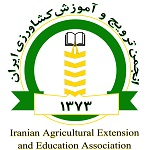

Volume 13, Issue 3 (2024)
QJIA 2024, 13(3): 81-99 |
Back to browse issues page
Download citation:
BibTeX | RIS | EndNote | Medlars | ProCite | Reference Manager | RefWorks
Send citation to:



BibTeX | RIS | EndNote | Medlars | ProCite | Reference Manager | RefWorks
Send citation to:
Rastgoo H, Abbasi E, Bijani M. Adaptive Capacities of the Agricultural Insurance Fund in the face of Natural Disasters. QJIA 2024; 13 (3) :81-99
URL: http://journal.sbkiran.ir/article-1-284-en.html
URL: http://journal.sbkiran.ir/article-1-284-en.html
Abstract: (291 Views)
The Agricultural Insurance Fund, with a history of approximately 40 years, is one of the support organizations active in the agricultural sector, which has both an effective and a highly effective role in the conditions caused by natural crises and damage to the production units of the agricultural sector. Currently, the services of this fund are available to all farmers and producers in the agricultural sector throughout the country by issuing nearly one million and three hundred insurance policies, in the form of more than 2000 insurance tariffs to cover about 175 products and production activities in various agricultural subsectors such as crops, orchards, livestock, poultry, aquaculture, and natural resources, against destructive natural factors such as drought, frost and freezing, floods, storms, etc. However, the aim of this research is to examine and identify the adaptability capacities of the Agricultural Insurance Fund in dealing with various natural crises and hazards that threaten agricultural production. In this way, this economic and supportive institution can follow its organizational development path while maintaining the necessary readiness in crisis conditions and adapting to new situations. This present study is a qualitative research in terms of research paradigm, applied in terms of purpose, and exploratory in terms of research type. The focus group method was used to interview key individuals and knowledgeable sources in the field of agricultural insurance. The statistical population of this research consisted of 14 specialists and experts in the field of agricultural insurance who were purposefully selected using snowball sampling method. In the first stage, one open-answer question with the topic "What are the influential and challenging natural crises for the Agricultural Insurance Fund?" and three open-answer questions including "What are the infrastructural capacities, human resources, and financial resources of the Agricultural Insurance Fund in dealing with natural crises?" were formulated and provided to the members of the focus group. After discussion and exchange of ideas, the final list was prepared. In the second stage, this list was presented to the members of the focus group for consensus, resulting in the identification of a total of 32 indicators as measures of the adaptation capacity of the Agricultural Insurance Fund in dealing with natural crises within five categories ((including: technical capabilities, information database, innovative technologies, human resources, and financial capacities).
Send email to the article author
| Rights and permissions | |
 |
This work is licensed under a Creative Commons Attribution-NonCommercial 4.0 International License. |




